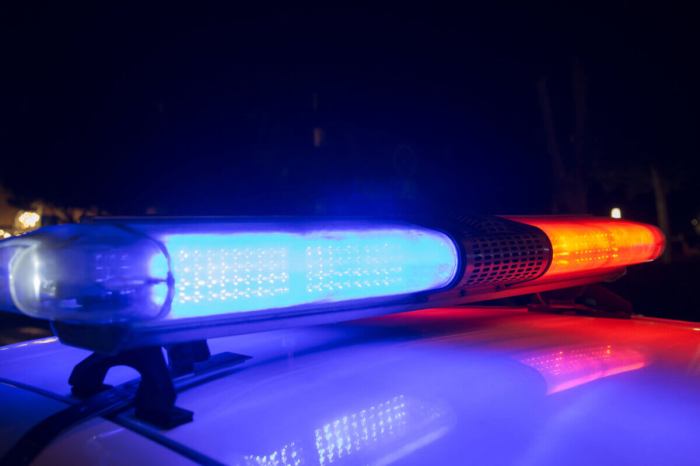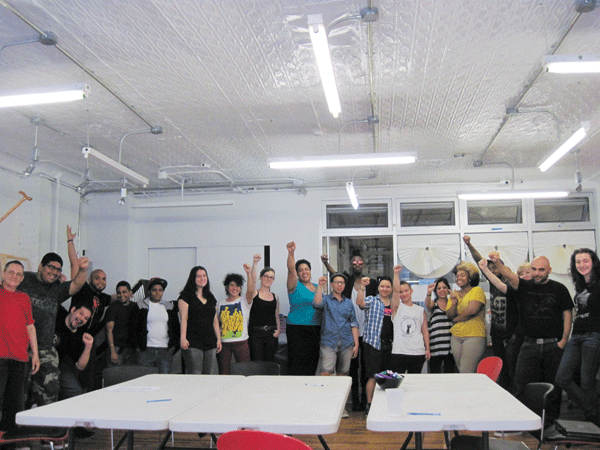
The LGBTQ advocacy groups at 147 West 24th Street raise their fists in the name of community — and family.
BY YANAN WANG | From the outside, there’s nothing remarkable about 147 West 24th Street. Walk the block between Sixth and Seventh Avenues, and you’re more likely to notice the 99 Cent store or the Hampton Inn hotel. Those looking for a sense of purpose and community, however, will find it — and not just at XES Lounge (a gay bar, at 157, with a similarly nondescript façade that belies the activity within).
A quick elevator trip at 147 reveals that the building is home to a unique community of activists. From the third floor to the sixth, the facilities are dedicated — in one way or another — to advocating for the rights of lesbian, gay, bisexual, two spirit, trans and gender non-conforming people.
With the elevator providing direct access to each of the organizations’ offices, there is a constant flow — of people and ideas — throughout the building. Many of the groups have overlapping membership, and some of them are collaborating on city-wide projects (a building meeting is held each month so the organizations can stay abreast of each other’s activities).
But at its core, the community at 147 West 24th Street extends beyond individual and collective organizing.
“The building’s like my family,” said Chris Bilal, a member of the campaign staff at Streetwise and Safe, an advocacy group on the fifth floor. “It’s a lot of people’s families.”
This family started as just one organization in 2006 — when Fabulous Independent Educated Radicals for Community Empowerment (FIERCE) became the first LGBTQ project to move into the building. Then, little by little, other groups joined them. The growth has allowed them to take on larger projects, said John Blasco, FIERCE’s lead organizer since 2009.
When big events are happening, noted Blasco, the building’s groups mobilize as a single contingent. On June 11, representatives from each of the building’s five LGBTQ groups (The Audre Lorde Project, Streetwise and Safe, Queers for Economic Justice, The Sylvia Rivera Law Project and FIERCE) spoke in solidarity at a press conference addressing police brutality against three gay young men in Bed-Stuy Brooklyn.
A few of the building’s groups host Know Your Rights training workshops to educate LGBTQ youth of color and low-income LGBTQ youth about how to protect themselves during police encounters.
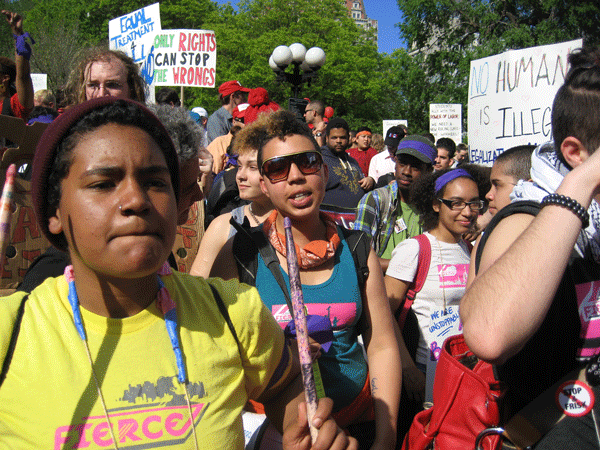
No one takes the Fabulous out of FIERCE.
FIERCE, Streetwise and Safe and the Audre Lorde Project are members of Communities United for Police Reform — a city-wide campaign against discriminatory policing practices such as stop and frisk. For LGBTQ individuals who are also homeless, low-income or people of color, the risk of being mistreated by authority figures only multiplies, said Amber Hollibaugh, the executive director of Queers for Economic Justice. She noted that all of the organizations in the building advocate for LGBTQ peoples who also belong to other marginalized groups.
“We’re not here by accident. We’re here because we share an agenda,” Hollibaugh said. “We often see the same people, and we care about similar, overlapping issues even though we work in different constituencies.”
As she put it, “We are the ones who see what it’s like to be part of a community and not be invited to the table.”
ENVISIONING LIBERATION, COLLECTIVELY
The Audre Lorde Project
alp.org
@audrelorde
718-596-0342
Over the course of her life, Audre Lorde held many jobs: factory worker, librarian, medical clerk. But she is best remembered by her admirers as a lifelong poet and writer — an activist who embraced multiplicity, in action and in identity. Lorde once declared, “I am defined as other in every group I’m part of…Yet without community there is certainly no liberation, no future, only the most vulnerable and temporary armistice between me and my oppression.”
It is this spirit of standing at the periphery and longing to be on the inside that has spawned a range of projects in Lorde’s honor since her death in 1992. Today, the Audre Lorde Project (ALP) offers its members precisely the kind of community and common ground for LGBTQ people that Lorde sought out in her lifetime.
In her discussion of the group’s mission statement, Executive Director Cara Page spoke of their duty to uphold Lorde’s memory. “We are about understanding all the multiplicities we have to hold to survive,” Page said. “Understanding that action comes with reflection, comes with safety comes with transformation.”
ALP operates through three different initiatives, all of which promote political education: Safe OUTSide the System, TransJustice and 3rd Space Support. The West 24th Street space is its second location in the city (ALP started 16 years ago in Brooklyn, at the Lafayette Presbyterian Avenue Church). Using the resources of its members to help them help one another, “ALP’s vision is always a collective vision,” Page said, noting that 3rd Space Support provides a framework for LGBTQ people to mobilize within their communities and support each other in matters surrounding employment, education, healthcare and immigration. The program involves not only referrals to useful outside resources, but also a health and wellness collective (called 3rd Space Healing) which is comprised of wellness practitioners trained in acupuncture and grief and trauma interventions.
All in all, ALP strives to help LGBTQ people put the resources that they already possess into helping the collective. This is true of their immigrant rights programming, which also functions as an opportunity for people who are skilled in interpreting to create a multilingual space for the organization.
According to Page, it is especially important for ALP to exist because of its place in a society that has completely dismissed the history of LGBTQ movements. “We’re still not seen as a major voice,” she said. “With the increased gentrification and poverty in this city, it feels at times impossible. But spaces like [the one] ALP offers makes it feel absolutely possible.”
A SCHOOL FOR THE STUDY OF STREET SMARTS
Streetwise and Safe (SAS)
sreetwiseandsafe.org
@SASYOUTHNYC
212-929-0562
The third time that Chris Bilal was stop-and-frisked, his transgression was dancing. While in Marcus Garvey Park along with two friends, Bilal was stopped by a group of police officers who asked them what they were doing standing on the amphitheater. They suspected, said Bilal, that the youth were performing a sexual act — when in truth, the only thing they were guilty of was “being gay and in a park.”
And while Bilal knew that they were violating his rights by questioning him without just cause, he said, he and his friends relented and allowed the officials to search their bags. The 25-year-old, an African-American queer youth, has become accustomed to being scrutinized for the way he looks.
“I’ve had six negative police encounters,” Bilal said. “That’s in addition to the looks I get every day because of the way that I dress.”
Over two years ago, Bilal saw an advertisement that would change his life. It was a flyer for Streetwise and Safe (SAS), an initiative aimed at instructing LGBTQ youth of color on how to exercise their rights when confronted by police officials. Through a 15-week intensive training program, SAS teaches its members strategies to protect themselves against discriminatory policing tactics.
Research conducted by the City University of New York found that LGBTQ youth reported experiencing verbal and sexual harassment from the police at twice the rate of non-queer youth, said SAS Co-Coordinator and Founding Member Andrea Ritchie. She added that while LGBTQ people of color face some of the same challenges as non-queer individuals of their ethnicity, they also encounter abuse that targets their sexual identity.
“If you’re a young gay man standing on the corner looking a particular way, even if you’re just hanging out with your friends, it’s immediately assumed that you are guilty of lewd conduct,” Ritchie said. “Or, if someone’s identification document is marked male or female in a way that the cop thinks is wrong, they will literally say to the person on the street, ‘Are you a boy or girl?’ and lift up their shirts to verify.”
The list of violations doesn’t stop there. “Cops will arrest LGBTQ youth, call them names like ‘faggot’ or ‘trannies,’ try to get their phone number and sexually harass them by grabbing their ass,” said Ritchie.
Although these kinds of searches are very much illegal under the constitution, she noted, many young people are unaware of how to assert their rights. The program trains them in simple strategies, such as avoiding dark corners or asking police officers for the cause of the search, that can save them from harassment.
On the policy front, SAS has been successful in pushing reforms on police conduct. In addition to advocating for legislation that would ban a range of discriminatory tactics, the organization was involved in changing the language in police conduct guides to reflect new rules for interacting with LGBTQ people.
Just two weeks ago, Bilal and his friend were driving when a police officer asked them to pull over. This time, Bilal didn’t let the encounter slip by. Instead, he recorded the police officer’s verbally abusive speech on his phone and used an app that sent the audio file directly to the New York Civil Liberties Union.
Actions like these demonstrate the impact of SAS. “We want to show youth that they can change the legal framework in which these encounters take place, so that later a lawyer can fight for them,” said Ritchie.
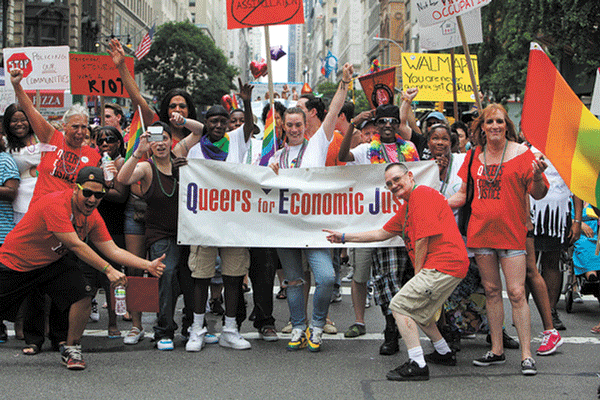
QEJ walks in the Pride March with a contingent of shelter, low-income and labor LGBTQ individuals.
MAKING POVERTY A PRIORITY
Queers for Economic Justice
q4ej.org
212-564-3608
“Often, there’s the assumption that we’re all wealthy, white and male,” said Queers for Economic Justice (QEJ) Director Amber Hollibaugh, referring to the lack of data on the financial status of LGBTQ people.
When the gay liberation movement first emerged out of the Stonewall riots in 1969, Hollibaugh explained, no demographic information had been gathered to determine “who is LGBTQ, where they were or whether they were wealthy.” The only data that had been collected was drawn from bookstore customers and magazines subscribers — both groups which reflected a white, wealthy clientele. As a result, most of the statistics of that era concerning LGBTQ people are hypothetical, she pointed out.
And while Hollibaugh acknowledged that things have certainly improved, she noted that LGBTQ people are still not recognized by most economic survey tools. In the census, for instance, someone may mark that they have a partner of the same sex, but they cannot identify themselves as a queer individual.
QEJ was founded as a response to this gap in recognition. It is built on the understanding that, perhaps more so than marriage equality, a healthy welfare system is essential to ensuring that LGBTQ people are able to survive and thrive.
“Even though we appear to be invisible in [economic] crises, this is our issue,” Hollibaugh remarked. “We can’t separate our sexual orientation or our gender identity from the way we live out our reality.” This reality includes practical matters, such as the tangible differences between living in a homeless shelter with a curfew, and having your own apartment to bring someone home to, she observed.
In earlier decades, queers may have found it appealing to support the mythos of wealth in their community, Hollibaugh guessed, because it made them appear more “useful” to society. This attitude has caused many LGBTQ movements to ignore the severity of the economic problems they face. In most establishments across the country, it is still impossible to be hired as someone who is openly queer, she said.
QEJ’s goal is to apply economic analysis to the financial problems facing LGBTQ people today.
“We pay a price for appearing wealthy when we’re not, so that marriage becomes the leading issue rather than questions of economic justice,” Hollibaugh said. “For many of us, marriage doesn’t change our situation: it doesn’t change whether we can get jobs, or whether we’re on the streets.”
April Dunlop, a Hampshire College student who is interning at QEJ this summer, has helped to establish an Indiegogo (an international crowdfunding platform) campaign to raise funds for the organization’s annual shelter, low-income and labor contingent in the Pride March. – See more at:https://chelseanow.com/2013/06/
With a goal to raise $3,000 before July 1 (the day after the parade), Dunlop said they hope to garner enough money to not only cover the costs of food and transportation for that day’s projected 120 participants, but also to pay for T-shirt-making supplies.
“Ideally we would like to buy supplies for them to decorate a T-shirt,” said Dunlop, “because that’s what everyone does at Pride. You put on your fanciest glittery clothing, and we want them to be able to take part in that too.”
Beyond spreading awareness for the plight of financially-needy LGBTQ people, QEJ has worked to ensure that their policy reforms in this regard are followed.
Hollibaugh noted, for instance, that while they successfully pushed the Department of Homeless Services to accept homosexual families into their family shelters, they have struggled to regulate employees’ adherence to this change. Due to a lack of oversight and a fast rate of turnover in welfare staff, she said, there are very few resources available to keep staff informed about new regulations.
“It’s one thing to get these important structural changes into the system,” said Hollibaugh. “It’s another to get implementation. That’s the comma in the sentence.”
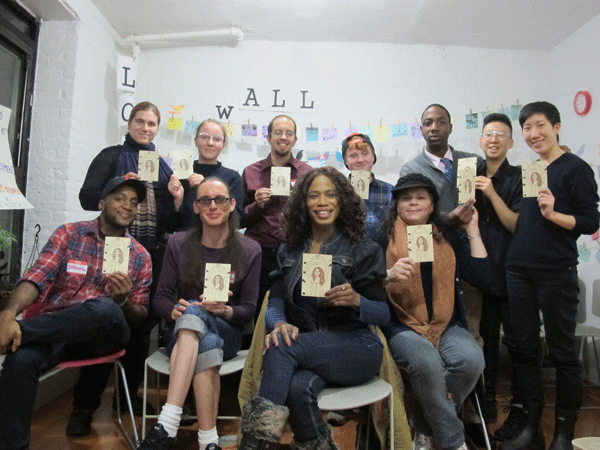
Smiles all around at SRLP.
LEGAL SOLUTIONS TO INSTITUTIONAL PROBLEMS
The Sylvia Rivera Law Project
srlp.prg
212-337-8550
Founded in 2002, the establishment of the Sylvia Rivera Law Project (SRLP) stemmed from a recognition that LGBTQ people were not receiving the legal services they needed to assert their right to determine their own identities. Since 2003, the group has been a collectively-run organization, with a non-hierarchical structure that enables all of the group’s seven staff members to pass the budget and future plans.
“All of us are executive directors of the organization,” said Reina Gossett, SRLP’s director of membership.
This collective structure is reflected in the group’s programming, which advocates for equality through a legal framework. At the forefront of SRLP’s initiatives are the free legal services it provides to its community members. The staff includes three lawyers who help LGBTQ people work through legal networks that may be particularly challenging given their sexual orientation, low-income status or ethnic background. In order to ensure that all individuals are free to express their gender, for instance, SRLP provides guidance for going through the paperwork of changing one’s gender marker.
Before Gossett came on board as a member of the group’s movement building team, she was one of its legal clients. Remarking that SRLP has made a name for itself in its constituent communities, Gosset recalled, “I had always heard amazing things about it from trans people in my community.”
Now, along with Gabriel Foster, she works to reach out to people who have been left behind by the systems they inhabit. For years, Foster has been active in engaging New York’s community of incarcerated LGBTQ people. Through a prisoner advisory committee, Foster coordinates activities designed to help LGBTQ people find each other within the prison industrial complex.
With a pen pal program, postcard mailings and a newsletter (called “In Solidarity”) showcasing the artistic work of incarcerated LGBTQ people, Foster has worked to break down the walls of isolation that enclose queer people in prison.
In contrast to the groups within the building that cater to young people, SRLP plays host to a wide range of age groups, with many older individuals amongst their clientele. One of SRLP’s biggest challenges, Gossett said, has been to create a safe space where the degree of people’s struggles may be radically different.
“People face trauma in disproportionate numbers, and that affects our relationships with each other,” she said, noting that the trick is to find a common ground, despite the differences in their past.
BUILDING SAFE SPACES
FIERCE
fiercenyc.org
@FIERCENYC
646-336-6789
In 1969, the Stonewall Inn was known to most as the gay bar in the city, and its location on Christopher Street only made it an even more attractive venue for New York’s burgeoning LBGTQ community. When the Stonewall riots occurred in September, there was no doubt in anyone’s mind that the district — and its openly colorful character — would become representative of that first monumental victory for many generations to come.
Today, the Christopher Street Pier is where FIERCE has decided to focus its organizing. While it continues to be a safe haven for LGBTQ youth, much like other areas of the queer activity across the city, the venue has been threatened by increased gentrification in recent years.
Lead organizer John Blasco said there has always been tension between West Village residents and the LGBTQ youth who frequent the area. There have been noise complaints, Blasco said, and attempts to shorten the amount of time for which the pier is open. FIERCE is working to ensure that this kind of resistance does not take away a valuable haven for LGBTQ youth.
“It’s always been a space where LGBTQ youth go to be themselves,” he said. “It’s a safe space in which they can express themselves.”
According to Blasco, one of the largest threats to the community is the call by some residents to increase police presence. This would not help LGBTQ youth, he said, as they are among the prime victims of harassment at the hands of police officers.
Blasco has spoken out against increased policing at the Christopher Street Pier at several press conferences and meetings, iterating the need to give LGBTQ youth a place where they are free from scrutiny.
“Increased policing doesn’t create safety for our folks,” he said. “Often times, it creates fear. It makes them vulnerable to more harassment.”
David Poster, president of a neighborhood civilian policing task force called the Christopher Street Patrole, has been the leading voice for closing down the pier at an earlier hour each night. But Blasco expressed gratitude that through their years of advocacy work, FIERCE has found other allies in the community.
FIERCE works closely with the Hudson River Park Trust, a committee that manages operations across the park, to plan events catering to the interests of LGBTQ youth. In the past, the trust has been supportive of FIERCE’s proposals.
Blasco stressed the importance of finding community allies who understand the challenges faced by LGBTQ youth. Once these relationships have been forged, Blasco explained, it becomes easier to plan events such as screenings of LGBTQ-oriented films.
Among its range of programming, FIERCE also organizes a three-month political education internship comprised of a series of workshops designed to help LGBTQ youth of color assert their rights in a variety of settings. The sessions are designed to be collaborative rather than merely instructive, Blasco said.
“Facilitators are not the only ones with answers,” Blasco remarked. “Everyone has answers. Everyone brings something to the table.”






